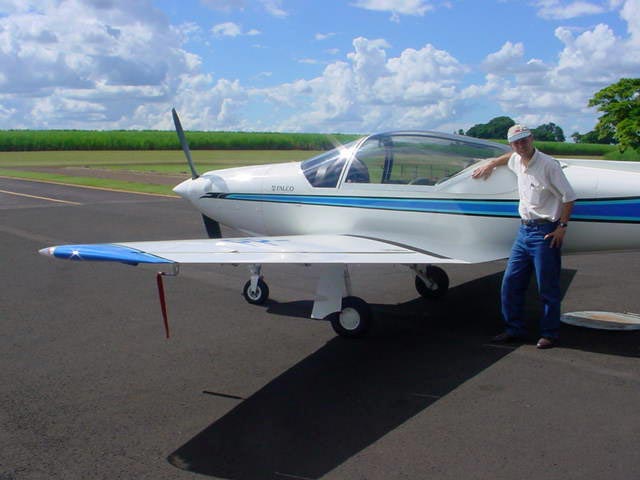Bravíssimo
![]()
Bravíssimo |
|
by Fernando Almeida
Photography by Fernando Machado-Aeromagazine
Translated by Sylvester Chávez and Edilberto Tasca
|
This article appeared in the Ano 9 - No. 105 issue of Aero magazine in Brazil, published in the spring of 2003 and it was also reprinted in the March 2003 Falco Builder Letter. |

An enormous hawk glides majestically over the cane field, riding a thermal. The bird of prey is not startled, instinctively flexing her wings slightly as she feels the wind eddies created by the swift passage of a white dart a few feet away. That's because both are winged members of the same family: A bird of prey and our white Falco, tail number PP-ZMB. Both exist to fly, pleasure in which they indulge freely this warm summer afternoon.
In the cockpit of the machine I capture this moment and salute the meeting with an aileron roll commanded by fingertips on the stick following a very gentle movement of my wrist resting on my thigh. At this moment I am fully conscious that I am at the controls of one of the most beautiful flying machines ever created by man, a paradigm of design and harmony of controls since 1955, the year of first flight of a 90 hp F.8 Falco.
The Falco F.8L is the masterpiece of a genius named Stelio Frati, an Italian aircraft designer who for the past 48 years has influenced the development of high performance single engine aircraft all over the world.

As James Gilbert, famous pilot and journalist, wrote in his book "The Great Planes":
All of Frati's designs are variations on a single theme; they all resemble each other, and each is instantly recognizable at a glance as "a Frati." They are finished as smoothly as mirrors, as though needless drag were more evil than the devil. They have the feel of tiny fighters, for you sit under a fighter pilot's sliding teardrop canopy, gripping a fighter pilot's stick, and the thing will be halfway round an aileron roll even before you've entirely made up your mind to do one. There is no superabundance of room in a Frati airplane, and they are all extremely noisy, but you will come down from your first flight in one with an unbelieving stare. It is much like the first time you ever drove a Ferrari; a damnation of all lesser vehicles for eternity. For the controls are so light, so delicate, the visibility so like falling free through space, and the airplane's stability even in turbulence so arrow-straight and intransmutable that you feel a fool for not knowing that light airplanes could be like this.
One hundred and one Falcos were built in Italy between 1956 and 1968 by three different companies: Aviamilano, Aeromere and Laverda. Its all-wood construction and specialized building methods finally doomed the Falco due to the elevated labor costs of highly skilled woodworkers. Since 1964, Stelio Frati diverted his attention to the design of his first all-metal aircraft, the advanced trainer F.250; negotiations with SIAI-Marchetti culminated in the production of a 260 hp powered version.

More than 600 SF.260s were built and went to serve in the air forces of 12 countries as advanced trainers and tactical support fighters-such as our Universal T-25 in Brazil. Marchetti also had a civilian version.
Going back to the F.8L, its production was stopped in 1968, until the beginning of the 1980s, when Sequoia Aircraft, of Richmond, Virginia, U.S.A. acquired from Stelio Frati the original blueprints for the F.8L Falco. Alfred Scott, president of Sequoia and the owner of an original Falco, converted the entire design in electronic form into a CAD (Computer Aided Design) system, introducing enhancements along the way aimed at the commercial production of the aircraft in "kit" form that would include all metal parts and assemblies plus other fabricated components, allowing the customer to do all the wood work. Shortly thereafter, Scott complemented the kit with the cockpit interiors, instrument panel, wing spars and ribs and totally finished frames. The result: A Falco F.8L reborn as a homebuilt, ready to accept a Lycoming powerplant of either 150, 160 or 180 hp, constant speed propeller and a Christen kit for inverted flight.

There are over 70 Falcos built from Sequoia kits, thanks to Alfred Scott's efforts towards excellence in the quality of the supplied materials and assembly instructions, lightening the enormous workload involved in the construction of a wooden structure designed over 50 years ago.
The aircraft we tested, tail number PP-ZMB, is the first Falco assembled in Brazil. Her builder has flown to Oshkosh with her and the airplane has now flown 500 hours of trouble-free joyous flight, with absolutely no problems whatsoever.
Let's get some technical data on Zulu-Mike-Bravo before we engage in the test-flight: The Falco is a two-seater sport plane of conventional configuration, low wing and side-by-side seats, retractable tricycle landing gear. In the specific case of PP-ZMB, the primary structure was built following the CAD design from Sequoia but, instead of the traditional spruce, called freijó, a native Brazilian ash wood was used, along with high-quality aircraft-grade plywood.

Marcelo Bellodi (mbellodi@usinasantaadelia.com.br) and his Falco, which he once flew to Oshkosh.
|
|
Go back to Falco Articles